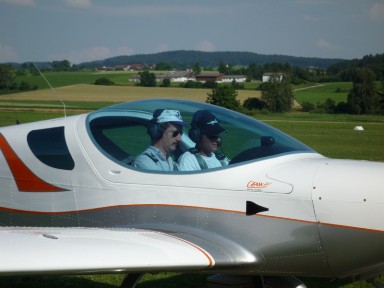03.07.2008: Today I went to finish the elevator, as I will be on vacation from the 9th July until the 6th August and I wanted it to be finished before we leave. I could not finish it earlier as the elevator trim servo was missing, but it arrived yesterday. I have to say that even though a few items were missing in the kit, I have in the meantime received everything from CZAW, and they always respond quickly to mails.
First, however, still a picture of Urs and myself, made by Thomas, of when we went flying with the SportCruiser on Monday this week. It nicely shows the headroom in the cockpit. I am 187 cm tall (6 ft 2″), and there is still a lot of room above my head. What you don’t see is that when the adjustable rudder pedals are in the front most position they are too far away even for for me! And even if pulled back the legs are always well below the instrument panel. From that I am sure that even somebody that is 2 m tall (6 ft 7″) sits comfortably in the SportCruiser.

The elevator trim servo is mounted on two angles inside the elevator. I realised that they were a little too long so I had to shorten them before drilling.
Below the whole assembly is mounted in the not yet closed elevator, just to see whether it fits correctly. The servo could be changed through the access panel, if necessary, but according to the plans the panel is riveted. These servos probably never fail.

Before closing the elevator I also came across another question. From what I saw in the assembly manual the rivets holding the round skin at the front of the elevator are “flush” riveted. Below a picture take from the manual:

I then had a look at pictures I took on PH-URS. Again, the rivets at the outer elevator hinge are more ore less flush.

Here the inner hinge underneath the rudder with the same picture.

On the ailerons, however, the rivets are standard and not flush.

I then checked the clearance between the rivets and the structure. From what I saw even round rivets have, once riveted, at least 3 to 4 mm clearance.

I also made some sample rivets into sunk holes. I realised that even then a little edge remains, and the rivet head is a maximum of 1 mm less high compared to a normally set rivet. I also tried to create lower heads by filing them a little (top right sample), in which case the difference in height is less than 0.5 mm, but the edge is much less prone to get stuck somewhere. After consulting with our mechanics we decided that I should install the rivets normally and file those few a little that pass the structure when the elevator deflects.

I then started to assemble the whole elevator with clecos for a last time…

…after which I riveted everything, including the composite tips. Below a picture of the finished elevator, mounted to the stabiliser. It moves incredibly well, thanks to the ball bearings used.

12.07.2008: After some unexpected troubles we are finally off towards Los Angeles for four weeks of vacation, so no further progress with the project will be reported until beginning of August. I am however currently checking with EAS how to certificate the SportCruiser in Switzerland. We intend to do this based on the PFA/LAA approval in the UK, as the EAS does cross-accept such approvals, I expect however that we still have to supply some engineering documents.

